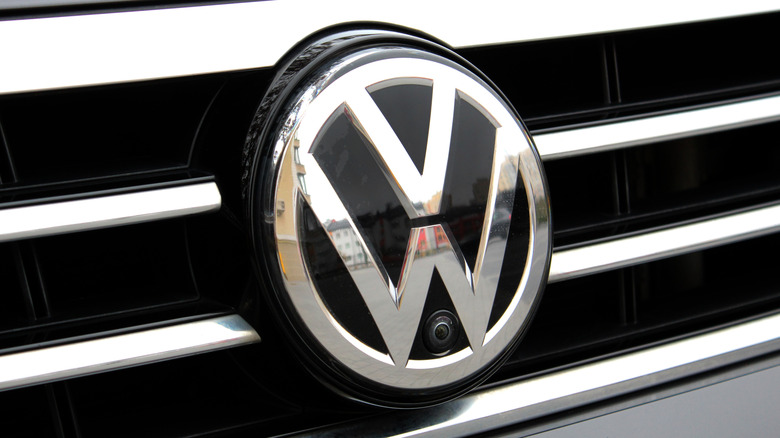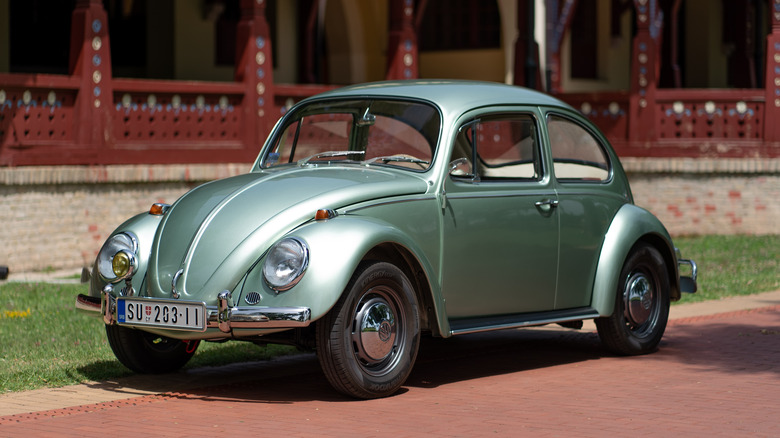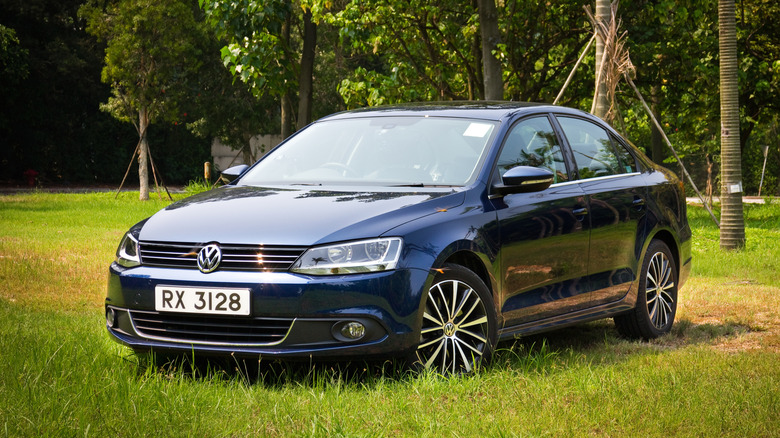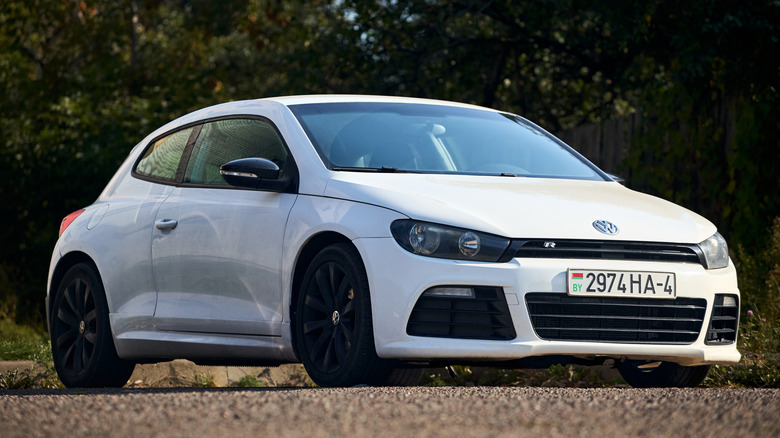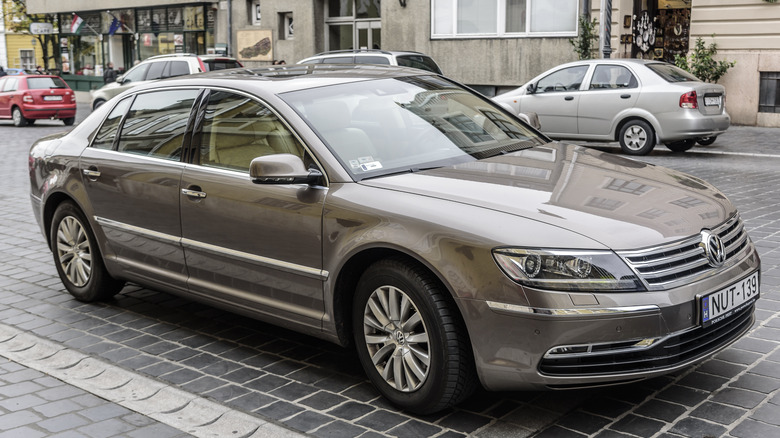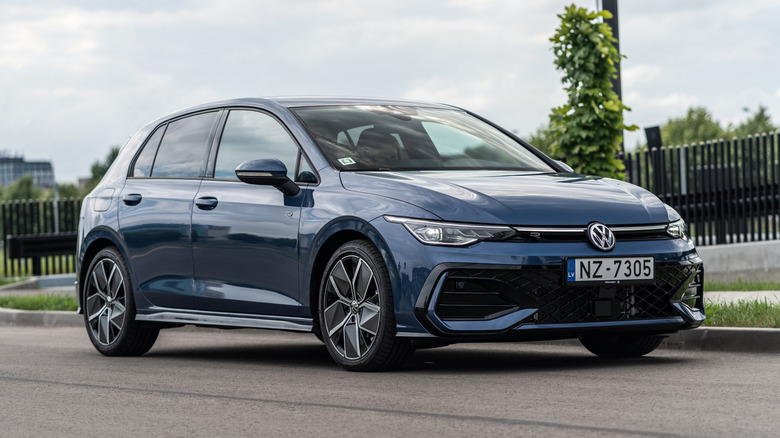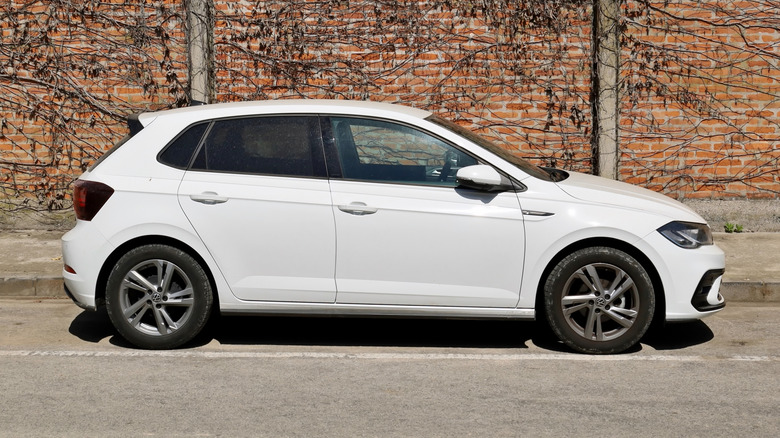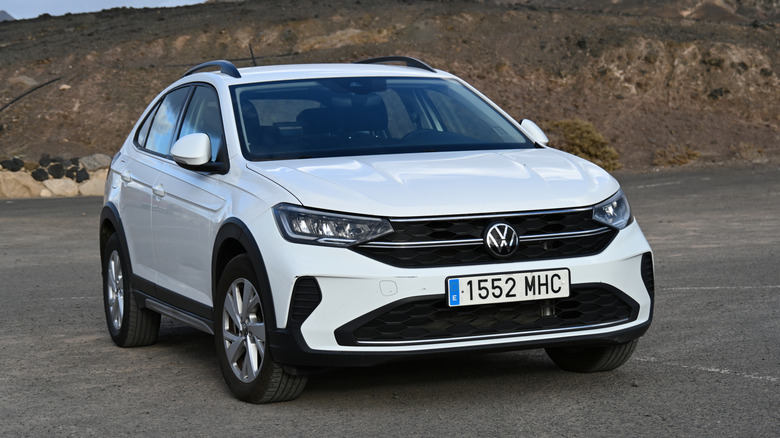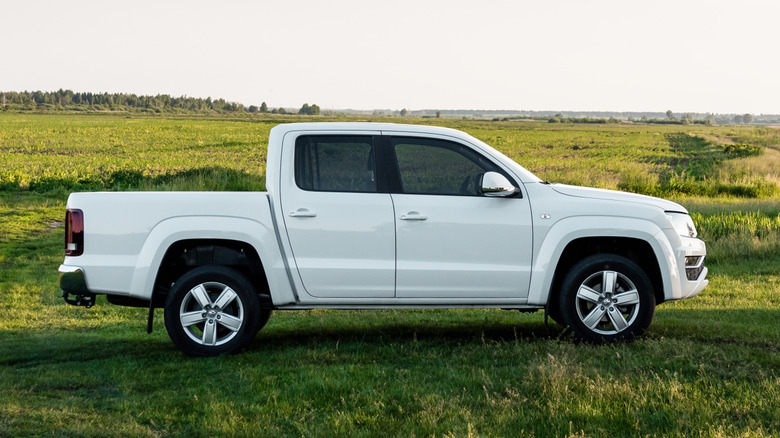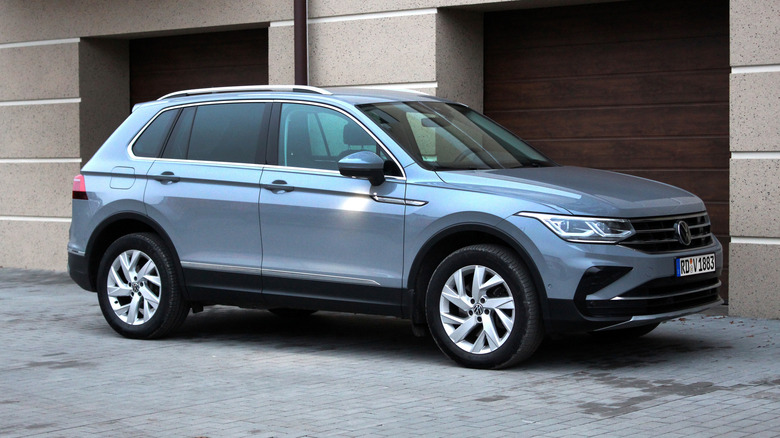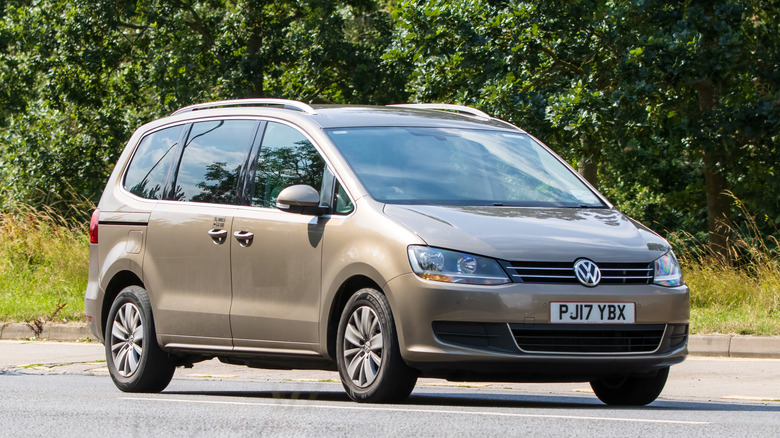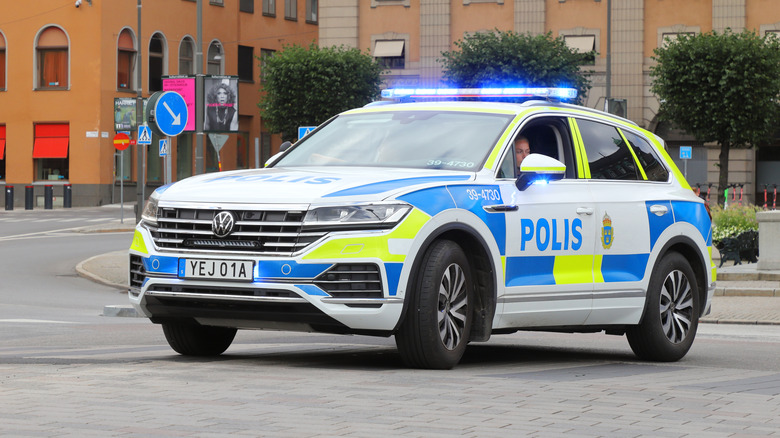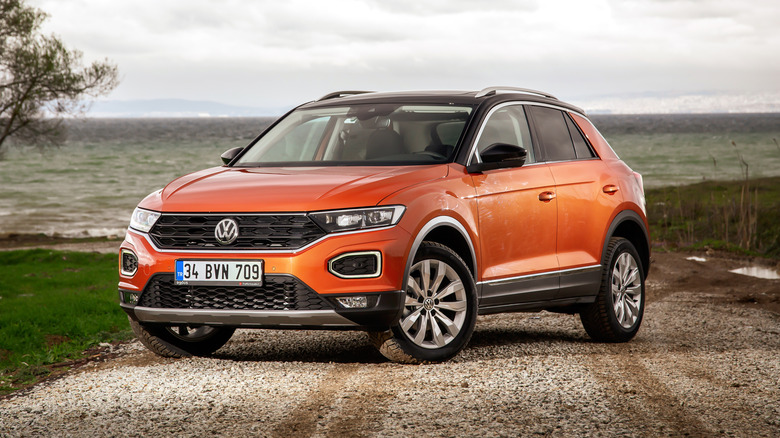13 Of The Oddest Names Volkswagen Has Used For Its Models
It's no secret that Volkswagen has come up with some of the most awkward and absurd car names in automotive history, but few people know what this company bases their names on — and the answer is mythology and weather. Specifically, German weather, though there is a bit of Middle Eastern influence in there somewhere.
A fact that you might already know is that VW has always been utterly obsessed with naming their cars after weather. Most have heard of the Volkswagen Golf — named after the Gulf Stream wind and not the sport where middle-aged men chase small white balls around perfectly manicured lawns while wearing trousers. Then there's the Passat, which comes from the German word for trade winds.
But that's where Volkswagen's naming department apparently decided to throw caution to the wind — quite literally. While Chevrolet names its cars after real places, and Lexus sticks to its two-letter alphanumeric soup, VW went completely mad with Germanic weather patterns and natural phenomena, with a good bit of mythology mixed in because why not — and some of these names are so obscure that even German speakers need a dictionary to figure out what their car is called. Some sound like medieval spells and others resemble geographical features you'd find on a hiking map. So, here are 13 Volkswagen model names that prove German engineers have far too much fun with their thesauruses.
Kafer
We begin our list with the Volkswagen Beetle, an automotive icon that came about as a result of Hitler wanting every German family to have their own car. This also happens to be one of the reasons Hitler built Germany's vast road network before World War II, but that's a story for another day. The Beetle got its name because it was nicknamed the "Kafer" by the Germans, a word that translates to "Beetle" in English, though this was not the official name that VW sold it under, as it was blandly named the Volkswagen "Type 1."
However, only a historian would call it the Type 1 today. The car has spawned many nicknames across the years, including Vocho, Coccinelle, Fusca, or Maggiolino — all of which translate to either "Beetle" or "insect" or "bug". The VW Beetle celebrated 15 million units produced way back in 1972 — more than 50 years ago — and the first-generation version would go on to reach 21 million units produced, making it the highest production number of a single-platform vehicle ever made. Today, we have a successor to the Volkswagen Beetle, but it'll never be as iconic as the Vochos of days gone by.
Jetta
The Jetta is one of VW's best compact sedan offerings, and it is approaching its 50th anniversary, having been introduced way back in 1979 as either a two-door or four-door model. Back then, it was sometimes referred to as the "Type 16," which was its official project name, but somewhere along the line, executives named it the "Jetta", after the jet stream winds that blow in Germany. Today, the latest Volkswagen Jetta is currently seven generations in, with the most recent platform update having debuted in 2019 on the MQB platform also shared with the Audi A1, A3, Q2, and Skoda's Fabia, among other C-segment cars.
The new model gets a fairly decent spec sheet in 2025, coming with a 1.5-liter four-cylinder engine making 158 hp and 184 lb-ft of torque, with base models being FWD and paired to an eight-speed automatic transmission. This setup gets the Jetta a stellar economy of 33 mpg combined, and though the handling is tuned for comfort, it can be quite fun to drive. Prices for this model year start at $22,495 (not including a $1,225 destination fee), making it a very affordable model for most people.
Scirocco
The Scirocco is another model that is named after a fast-moving wind. Specifically, Scirocco (sometimes called the Sirocco) is the Italian word for a hot African wind that comes in from over the Sahara, blowing over various places in the Mediterranean, sometimes significantly raising temperatures in the places it affects. Since the VW Scirocco was a two-door sports coupe, the name was likely chosen to evoke feelings of speed and power, given the nature of its namesake.
The model was produced between 1974 and 1992, and then revived in 2008 for a 10-year production run that ended in 2017, and just as the initial Scirocco was based on the Golf platform, so was the revival. In its last model year it came in with a 2.0-liter engine making 181 hp and 207 lb-ft of torque, with a base MSRP of £20,455 ($27,500) — the perfect balance of price and performance, which is probably why it was so popular with the younger generation, and equally why VW should have sold it here. Today, the closest thing VW offers to a three-door sports coupe is the Golf and, by extension, the much more aggressive Golf R — and it's a real shame that the Scirocco won't be coming back any time soon.
Phaeton
The Phaeton is the first car on our list that deviates from the named-after-a-wind trope, as it is named after Phaëton, who was the son of Helios according to Greek mythology. For a very long time, the Phaeton had the longest wheelbase of any VW car, a title that is currently held by the Volkswagen Grand California. Another interesting fact that not many people know about the Phaeton is that it was one of the first models to get the legendary 444 hp, 413 lb-ft of torque 6.0-liter W12 engine that also came in the 2001 Audi A8 and Bentley Continental — quite a big step up from the already insane V10 that was stuffed into the Touareg.
Might we remind you that both the Touareg and Phaeton were intended to be family vehicles, so the decision to cram high-displacement engines into them did raise a few eyebrows, so to speak. By the time it was discontinued, the Phaeton came standard with a 3.6-liter engine making 280 hp and 273 lb-ft of torque, down from the W12 glory days, thanks mostly to emissions regulations.
Golf
The VW Golf is named after the Gulf Stream ocean current. Also, "Golf" was the name of the favorite horse of a key VW executive, which may be the real name inspiration for this model. The Mk1 Golf first rolled off the factory lines by the end of the first quarter of 1974, a year after the Scirocco and in the same period as the Passat, arriving at dealers by the end of May the same year. Just two short years later, in 1976, VW celebrated Golf number one million, and production never looked back.
Over the years, there have been eight different generations (Mk1 through Mk8) of the VW Golf, the latest of which came about smack in the middle of the COVID-19 pandemic. Currently, both models of the 2025 Volkswagen Golf, namely the R and the GTI, are available in the U.S. The $32,445 GTI has a 2.0-liter engine making 241 hp and 273 lb-ft of torque, while the significantly more expensive $47,100 Golf R has a 2.0-liter turbocharged engine making 328 hp and 295 lb-ft of torque. While slightly on the pricier side, both of these are fantastic cars and are, honestly, probably among the last true hot hatches that will ever be sold.
Polo
Many people will tell you that the Volkswagen Polo is simply a smaller version of the Golf — and those many people would be sorely wrong. While the Golf is a compact car, just like the Polo, that's where the similarities end as the Polo is actually classified as a "supermini", or in other words, a B-segment vehicle. In addition to that, the Polo has different engine options, a different interior, different dimensions, pricing, design, performance, you name it. As for the name, VW went back to their comfort corner, naming the Polo after the icy Polar winds that originate at the North and South Poles.
Interestingly, the Polo was declared the best supermini vehicle of 2019 in the UK, a title which it definitely deserves — it's comfortable, sporty, and will not require the sale of any major organs to purchase in 2025: what more could one want? The 2025 Polo comes with a tiny 1.0-liter engine that churns out 80 hp and 69 lb-ft of torque, with a base price of £21,470 in the UK, which is about $28,866. Unfortunately, the Polo has never been sold in the U.S., though it has been very successful in other markets around the world. However, it's understandable why VW made this decision, as the Polo would have gobbled up a lot of Volkswagen's market share here in the U.S. by simply being too good.
Passat
The word "Passat" comes from the German word for trade winds, which is "Passatwinde" — a nameplate chosen to represent a fast, powerful, and important car for executives. The model launched in 1973, just a year after the Scirocco that we covered above, and sold over 30 million units worldwide during its lifetime. We should mention that the U.S. didn't get its own Passat until 1990, before which VW sold a Passat-based sedan called the "Dasher" from 1974, which it renamed the "Quantum" in 1982.
From 2011, Passats were manufactured at the giant Volkswagen plant in Chattanooga, TN. However, just one year before its 50th anniversary in 2023, VW decided to axe the model and repurpose the Chattanooga plant to make electric vehicles instead. The last run of Passats also had a few special editions that paid homage to the city of Chattanooga and its history, a nod to the decade or so that the plant had been producing the model. By the time it was on the chopping block, the Passat rocked a 2.0-liter four-cylinder engine making 174 hp and 206 lb-ft of torque, coming in at a surprisingly okay $28,570.
Nivus / Taigo
There's an amusing story behind the other name, Nivus. VW's purpose behind the word is unclear, but we can confirm that "Nivus" is the Estonian word for "groin" — a fact that has led to a certain amount of joking and online trolling. In most markets around the world, the Volkswagen Nivus is currently sold as the Taigo, a combination of the words "Tiger" and "Taiga". In VW's own words, the current name (Taiga) is meant to represent "a feeling of strength, outdoors, and adventure" — though we're unsure if anyone is taking this mini crossover any further than the pavement.
Digs aside, the SUV is a decent offering, though there are better cars for the money, with the base "life" trim coming in with a one-liter engine mated to a five-speed manual transmission, pushing out 95 hp and 129 lb-ft of torque. Prices currently start at £24,770 ($33,300) for the entry-level models, climbing quickly as you get into better trims, which is why you should look elsewhere if you're planning on buying anything other than the base model.
Amarok
The Amarok was Volkswagen's first one-ton pickup truck, having debuted in 2010. However, the Amarok is not the first pickup that VW offered — that distinction goes to the 1970s Volkswagen Rabbit pickup, based on the Golf/Rabbit platform. Anyway, being the company's only modern ute (short for "utility", which is what the Australians call pickups), VW had to come up with a unique name for this. They settled on naming it after an Inuit beast, a wolf that preys on solitary hunters in the night.
It is said that if you hunt alone in the forests, the Amarok will come and prey on you, making meals exclusively out of solitary hunters — undoubtedly one of the coolest name choices for any car, ever. When it launched in 2010, the only available specification was a hulking four-door, double-cab version, though a single-cab two-door version followed in 2011. Like all the other cool VW models, however, the Amarok was said to be too costly to homologate in North America, which is why it was never sold in the U.S. — bummer.
Tiguan
Just like the Taigo that we covered above, this VW SUV's name is also an amalgamation of two words — this time, the words "Tiger" and "Iguana". It is a clear departure from the brand's weather-mythology name scheme, and that's because VW didn't name the car at all — the public did. When the car was still in the development phase, Volkswagen ran a naming competition through German car magazine publishers AutoBild to christen their new model. Eventually, after more than 350,000 readers had voted, the name "Tiguan" was chosen over contenders such as Samun, Namib, Rockton, and Nanuk.
The choice of name is probably to indicate that the car is tough, rugged, and adaptable to many situations, though this is our reasoning, not officially endorsed by VW. While the reasoning behind this choice isn't clear, the Tiguan is still a fantastic car. The Tiguan is currently powered by a 2.0-liter four-cylinder engine with 201 hp, 221 lb-ft of torque, and an eight-speed automatic transmission. In 2025, it retails for $29,495 (ex. destination) on the lower end — an amazing price for all the features that you get, atypical of the current slew of overpriced, underperforming large SUVs.
Shahran
Another major (and refreshing) departure from the weather naming system is the Volkswagen Sharan, which shares the name of one of the largest Arabic tribes, called the "Shahran". And the name befits the vehicle as well, with the VW Sharan being the brand's first full-size people-carrier minivan produced from 1995, known for its spaciousness, seating layout, and practicality. That said, Volkswagen maintains that Sharan (which also means "Carrier of Kings" in Persian) is a made-up name not meant to resemble anything.
Interestingly, the Volkswagen Sharan shares the same platform as the SEAT Alhambra and the vastly popular Ford Galaxy. The Volkswagen Sharan and Ford Galaxy were two parts of the same project, having been designated as a joint venture by the two companies way back in 1991. The Sharan was a fairly successful car, having sold its millionth unit more than six years ago in April 2019, and was available in more than 33 markets while it was still in production. In its closing years, the Sharan had a 1.4-liter engine with 150 hp, and could seat up to seven people comfortably across several rows.
Touareg
One of the most popular VW models to date, and one that is still being produced today, is also named after a tribe. The tribe in question is the Tuareg people, who are nomadic and native to the deep Sahara, with a VW rep saying that the name is inspired by their qualities of adaptation and strength. Currently, the Touareg is still selling like hotcakes around the world, and it was in the United States until 2017, but it has since been replaced by the VW Atlas, another large SUV.
However, in countries where it is still being sold (like the U.A.E.), the base model 2025 Touareg comes with an eight-speed automatic transmission and a two-liter engine producing 185 hp and 273 lb-ft of torque. Prices start from a not-insignificant but not break-the-bank 199,990 AED, which equates to about $54,458 at the time of writing. While the Atlas is a perfectly competent SUV, and the T-Roc slots in nicely below it, we hope that the iconic Touareg will return to the States.
T-Roc
And finally, the last car on our list is the Volkswagen T-Roc. By now we think that VW was running out of ideas, as the "T" in T-Roc is simply a nod to the Tiguan and Touareg that came before it, and is probably the result of some high-level executive going "all the other SUVs start with a T, so this one should too."
Volkswagen says that, and we are quoting them directly here, "The 'Roc' in the name has been derived from the English 'Rock', which stands for the positioning of the T-Roc as a crossover that combines the dominance of an SUV with the agility of a compact hatchback model. This car really rocks the segment – sometimes louder and sometimes more subdued." Sometimes you've got to wonder whose job it is to write this stuff, even if you offer a very nice 1.0-liter econobox engine with 115 hp and 148 lb-ft of torque at the very attractive price point of £29,410 ($39,400).
